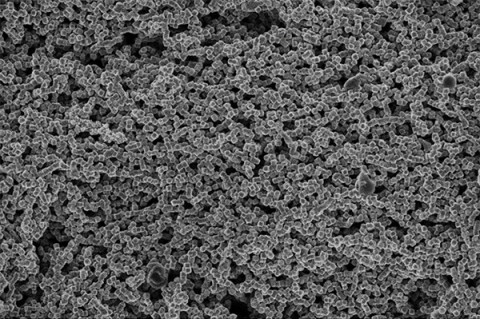ICMM-CSIC develops a new method for biodegradable electronics

The Materials Science Institute of Madrid (ICMM), part of the Spanish National Research Council (CSIC), has achieved the chemical synthesis of nanoparticles (measuring one-millionth of a millimeter) of metals for use in conductive nano-inks employed in printed electronics. This development paves the way for carbon-zero and biodegradable technology since these metals decompose naturally without leaving toxic residues. The study has been published in the journal Advanced Functional Materials.
"We use iron, nickel, and their alloys because they are biodegradable metals naturally present in our environment: from our blood to the soil or the food we eat," explains Puerto Morales, a researcher at ICMM-CSIC and the study's lead author. She says that developing smart objects currently and inevitably involves integrating highly polluting electronic components, and thus, the challenge is developing products with materials and processes that are more efficient and environmentally friendly. "Our HyPElignum project aims to create electronics with products that naturally decompose without leaving toxic residues, and that's precisely what iron and nickel do," she adds.
They have relied on printed electronics, which uses printing technology to create ultrathin, lightweight, flexible, and large-surface products. "These new magnetic and conductive materials in printed electronics open up a range of possibilities for applications such as wireless device charging, among others," comments Antonio Santana, also a researcher at ICMM, which is under the Ministry of Science, Innovation, and Universities (MCIU).
Among the components of these printed electronics are inks containing conductive nanoparticles. "Typically, these are gold or silver, which are highly conductive and also do not oxidize; this is good for durability but problematic for recycling since they do not change their properties over time," Morales explains. Moreover, the problem with these metals is their scarcity, and consequently, their high economic cost, as well as the fact that traditional synthesis methods for gold and silver "are very polluting and consume a lot of energy," she emphasizes.
Iron and nickel solve this: they are very abundant in nature in various forms (making them cheap), and they are biodegradable, decomposing without leaving residues as they simply reintegrate into nature where they originally came from. Additionally, this decomposition occurs very quickly when working with them at the nanometric scale (one billionth of a meter, making them imperceptible to the human eye). Their problem for electronics is oxidation, but ICMM has developed a very efficient and environmentally friendly treatment to prevent it using chemical methods in suspension, in water or alcohol, and microwave heating: "energetically, it is very efficient and fast," says Morales.
"We have produced nanoparticles that, in addition to being conductive, are magnetic, and when heated to temperatures below 220 degrees, which is low compared to the temperatures needed for gold and silver, they already conduct well," the scientist points out. They have already managed to produce useful nanoparticles at a "highly reproducible" level: "So far, we have grams, but our idea is to scale up production by carrying out the synthesis in a continuous microwave process," she concludes.
Reference: Belén Corrales-Pérez, Carlos Díaz-Ufano, María Salvador, Antonio Santana-Otero,Sabino Veintemillas-Verdaguer, Valerio Beni, and María del Puerto Morales. Alternative Metallic Fillers for the Preparation of Conductive Nanoinks for Sustainable Electronics. Advanced Functional Materials. DOI: 10.1002/adfm.202405326
Instituto de Ciencia de Materiales de Madrid (ICMM)
Sor Juana Ines de la Cruz, 3
Cantoblanco, 28049
Madrid, España
Telephone: (+34) 91 334 90 00
Email: @email
Communication Office: @email

Acknowledge the Severo Ochoa Centres of Excellence program through Grant CEX2024-001445-S/ financiado por MICIU/AEI / 10.13039/501100011033

Contacto | Accesibilidad | Aviso legal | Política de Cookies | Protección de datos